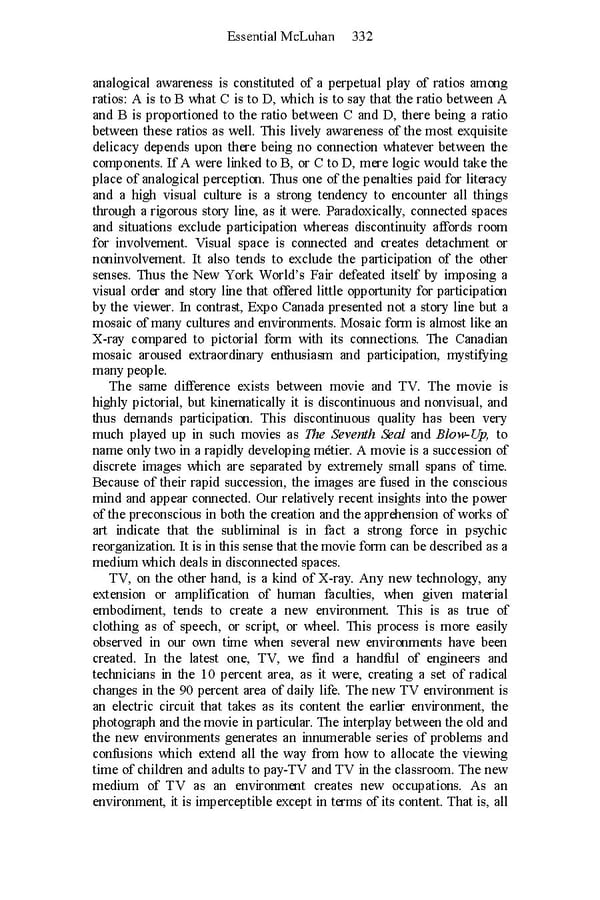Essential McLuhan 332 analogical awareness is constituted of a perpetual play of ratios among ratios: A is to B what C is to D, which is to say that the ratio between A and B is proportioned to the ratio between C and D, there being a ratio between these ratios as well. This lively awareness of the most exquisite delicacy depends upon there being no connection whatever between the components. If A were linked to B, or C to D, mere logic would take the place of analogical perception. Thus one of the penalties paid for literacy and a high visual culture is a strong tendency to encounter all things through a rigorous story line, as it were. Paradoxically, connected spaces and situations exclude participation whereas discontinuity affords room for involvement. Visual space is connected and creates detachment or noninvolvement. It also tends to exclude the participation of the other senses. Thus the New York World’s Fair defeated itself by imposing a visual order and story line that offered little opportunity for participation by the viewer. In contrast, Expo Canada presented not a story line but a mosaic of many cultures and environments. Mosaic form is almost like an X-ray compared to pictorial form with its connections. The Canadian mosaic aroused extraordinary enthusiasm and participation, mystifying many people. The same difference exists between movie and TV. The movie is highly pictorial, but kinematically it is discontinuous and nonvisual, and thus demands participation. This discontinuous quality has been very much played up in such movies as The Seventh Seal and Blow-Up, to name only two in a rapidly developing métier. A movie is a succession of discrete images which are separated by extremely small spans of time. Because of their rapid succession, the images are fused in the conscious mind and appear connected. Our relatively recent insights into the power of the preconscious in both the creation and the apprehension of works of art indicate that the subliminal is in fact a strong force in psychic reorganization. It is in this sense that the movie form can be described as a medium which deals in disconnected spaces. TV, on the other hand, is a kind of X-ray. Any new technology, any extension or amplification of human faculties, when given material embodiment, tends to create a new environment. This is as true of clothing as of speech, or script, or wheel. This process is more easily observed in our own time when several new environments have been created. In the latest one, TV, we find a handful of engineers and technicians in the 10 percent area, as it were, creating a set of radical changes in the 90 percent area of daily life. The new TV environment is an electric circuit that takes as its content the earlier environment, the photograph and the movie in particular. The interplay between the old and the new environments generates an innumerable series of problems and confusions which extend all the way from how to allocate the viewing time of children and adults to pay-TV and TV in the classroom. The new medium of TV as an environment creates new occupations. As an environment, it is imperceptible except in terms of its content. That is, all
 Essential McLuhan Page 338 Page 340
Essential McLuhan Page 338 Page 340